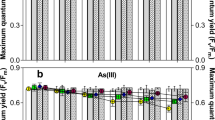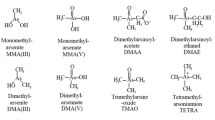Abstract
Arsenic speciation and cycling in the natural environment are highly impacted via biological processes. Since arsenic is ubiquitous in the environment, microorganisms have developed resistance mechanisms and detoxification pathways to overcome the arsenic toxicity. This study has evaluated the toxicity, transformation and accumulation of arsenic in a soil microalga Scenedesmus sp. The alga showed high tolerance to arsenite. The 72-h 50 % growth inhibitory concentrations (IC50 values) of the alga exposed to arsenite and arsenate in low-phosphate growth medium were 196.5 and 20.6 mg L−1, respectively. When treated with up to 7.5 mg L−1 arsenite, Scenedesmus sp. oxidised all arsenite to arsenate in solution. However, only 50 % of the total arsenic remained in the solution while the rest was accumulated in the cells. Thus, this alga has accumulated arsenic as much as 606 and 761 μg g−1 dry weight when exposed to 750 μg L−1 arsenite and arsenate, respectively, for 8 days. To our knowledge, this is the first report of biotransformation of arsenic by a soil alga. The ability of this alga to oxidise arsenite and accumulate arsenic could be used in bioremediation of arsenic from contaminated water and soil.


Similar content being viewed by others
References
Bahar MM, Megharaj M, Naidu R (2012) Arsenic bioremediation potential of a new arsenite-oxidizing bacterium Stenotrophomonas sp. MM-7 isolated from soil. Biodegradation 23:803–812
Bhumbla DK, Keefer RF (1994) Arsenic mobilization and bioavailability in soils. In: Nriagu JO (ed) Arsenic in the environment, part 1: cycling and characterization. Wiley, New York, pp 51–82
Campos VL, Escalante G, Yañez J, Zaror CA, Mondaca MA (2009) Isolation of arsenite-oxidizing bacteria from a natural biofilm associated to volcanic rocks of Atacama Desert, Chile. J Basic Microbiol 49:S93–S97
Chen Z, Akter KF, Rahman MM et al (2008) The separation of arsenic species in soils and plant tissues by anion-exchange chromatography with inductively coupled mass spectrometry using various mobile phases. Microchem J 89:20–28
Cullen WR, Reimer KJ (1989) Arsenic speciation in the environment. Chem Rev 89:713–764
Edvantoro BB, Naidu R, Megharaj M, Singleton I (2003) Changes in microbial properties associated with long-term arsenic and DDT contaminated soils at disused cattle dip sites. Ecotoxicol Environ Saf 55:344–351
Edvantoro BB, Naidu R, Megharaj M, Merrington G, Singleton I (2004) Microbial formation of volatile arsenic in cattle dip site soils contaminated with arsenic and DDT. Appl Soil Ecol 25:207–217
Ellis PJ, Conrads T, Hille R, Kuhn P (2001) Crystal structure of the 100 kDa arsenite oxidase from Alcaligenes faecalis in two crystal forms at 1.64 Å and 2.03 Å. Structure 9:125–132
Jahan K, Mosto P, Mattson C, Frey E, Derchak L (2006) Microbial removal of arsenic. Water Air Soil Pollut 6:71–82
Karadjova IB, Slaveykova VI, Tsalev DL (2008) The biouptake and toxicity of arsenic species on the green microalga Chlorella salina in seawater. Aquat Toxicol 87:264–271
Levy JL, Stauber JL, Adams MS, Maher WA, Kirby JK, Jolley DF (2005) Toxicity, biotransformation, and mode of action of arsenic in two freshwater microalgae (Chlorella sp. and Monoraphidium arcuatum). Environ Toxicol Chem 24:2630–2639
Maeda S, Nakashima S, Takeshita T, Higashi S (1985) Bioaccumulation of arsenic by freshwater algae and the application to the removal of inorganic from an aqueous phase. Part II. By Chlorella vulgaris isolated from arsenic-polluted environment. Sep Sci Technol 20:153–161
Mandal BK, Suzuki KT (2002) Arsenic round the world: a review. Talanta 58:201–235
Megharaj M, Venkateswarlu K, Rao A (1986) Growth response of four species of soil algae to monocrotophos and quinalphos. Environ Pollut 42:15–22
Ng JC, Moore MR (2005) Arsenic in drinking water: a natural killer in Bangladesh and beyond. Med J Aust 183:562–563
Nriagu JO, Bhattacharya P, Mukherjee AB, Bundschuh J, Zevenhoven JR, Loeppert RH (2007) Arsenic in soil and groundwater: an overview. Trace Metals Other 9:3–60
Qin J, Lehr CR, Yuan C, Le XC, McDermott TR, Rosen BP (2009) Biotransformation of arsenic by a Yellowstone thermoacidophilic eukaryotic alga. Proc Natl Acad Sci 106:5213–5217
Rahman MM, Asaduzzaman M, Naidu R (2011) Arsenic exposure from rice and water sources in the Noakhali District of Bangladesh. Water Qual Expo Health 3:1–10
Smedley PL, Kinniburgh DG (2002) A review of the source, behaviour and distribution of arsenic in natural waters. Appl Geochem 17:517–568
Suhendrayatna OA, Kuroiwa T, Maeda S (1999) Arsenic compounds in the freshwater green microalga Chlorella vulgaris after exposure to arsenite. Appl Organometallic Chem 13:127–133
Van Zwieten L, Ayres M, Curran P (1998) Remediation of contaminated soil and fluid at cattle dip sites in Australia. In: Kennedy IR, Skerritt JH, Johnson GI, Highley E (eds) Seeking agricultural produce free of pesticide residue. Australian Centre for International Agricultural Research, Canberra, pp 349–357
Vocke RW, Sears KL, O’Toole JJ, Wildman RB (1980) Growth responses of selected freshwater algae to trace elements and scrubber fish slurry generated by coal-fired power plants. Water Res 14:141–150
Wang J, Chen C (2006) Biosorption of heavy metals by Saccharomyces cerevisiae: a review. Biotech Adv 24:427–451
Weeger W, Lievremont D, Perret M et al (1999) Oxidation of arsenite to arsenate by a bacterium isolated from an aquatic environment. Biometals 12:141–149
WHO (1993) Guidelines for drinking water quality, volume 1: recommendations. 2nd edn. Geneva. http://www.who.int/water_sanitation_health/dwq/gdwq2v1/en/. Accessed 6 June 2012
Wong PK, Chang L (1991) Effect of copper, chromium and nickel on the growth, photosynthesis and chlorophyll a synthesis of Chlorella pyrenoidosa 251. Environ Pollut 72:127–139
Yin X-X, Wang LH, Bai R, Huang H, Sun G-X (2012) Accumulation and transformation of arsenic in the blue-green alga Synechocysis sp. PCC6803. Water Air Soil Pollut 223:1183–1190
Zayed A, Gowthaman S, Terry N (1998) Phytoaccumulation of trace elements by wetland plants: I. Duckweed. J Environ Qual 27:715–721
Zhu YL, Zayed AM, Qian J-H, de Souza M, Terry N (1999) Phytoaccumulation of trace elements by wetland plants: II. Water hyacinth. J Environ Qual 28:339–344
Acknowledgments
M.M. Bahar gratefully acknowledges the Govt. of Australia for providing the IPRS scholarship and University of South Australia for the postgraduate award during this study.
Author information
Authors and Affiliations
Corresponding author
Rights and permissions
About this article
Cite this article
Bahar, M.M., Megharaj, M. & Naidu, R. Toxicity, transformation and accumulation of inorganic arsenic species in a microalga Scenedesmus sp. isolated from soil. J Appl Phycol 25, 913–917 (2013). https://doi.org/10.1007/s10811-012-9923-0
Received:
Revised:
Accepted:
Published:
Issue Date:
DOI: https://doi.org/10.1007/s10811-012-9923-0




